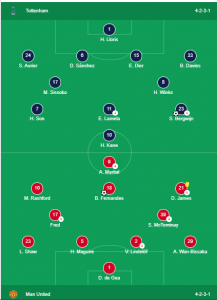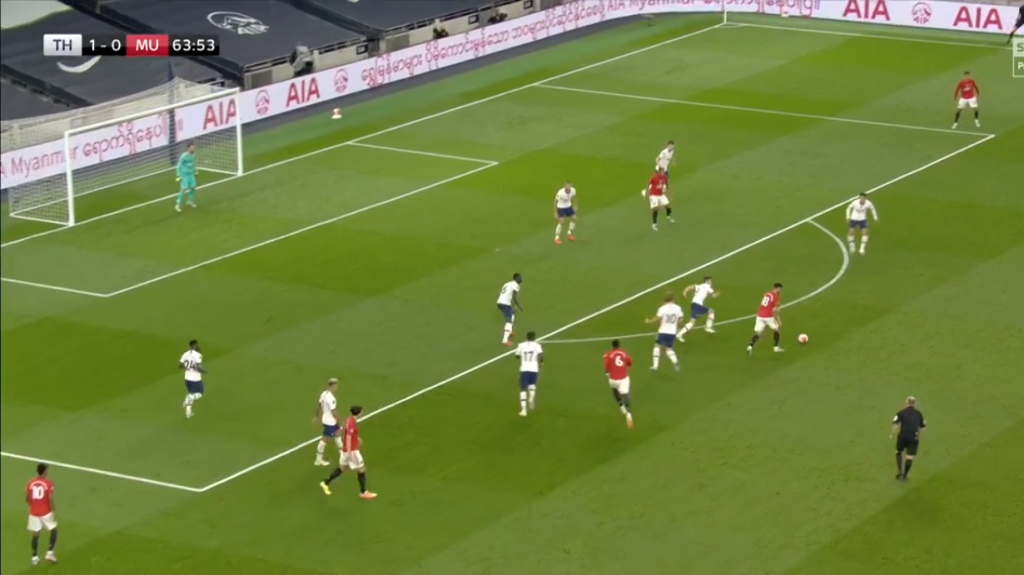Spurs re-began the season against Manchester United with a Champions League place at stake. Jose Mourinho opted for his trademark 4-2-3-1, while Ole also opting for the 4-2-3-1. On paper this looked like the following:
Lamela took over the ‘Alli role’ with Bergwijn playing on the right and Son on the left. In the early phases of the game, Spurs’ shape and pattern became clear. They sat in a 4-4-2 medium block, passively covering passing lanes to block build up.
Kane and Lamela blocking the passing lanes into Fred and McTominay respectively. The wide midfielders then covered the passing option to the wide areas, leaving Winks and Sissoko screening the back 4. This was effective for Spurs in the early phases of the match often leading to Manchester United recycling possession backward, once the ball was forced outward the corresponding attacker (i.e. Kane/ Lamela) would block the inside passing option which would set up a trap. This was particularly effective down the left-hand side with Son completing 4 interceptions (whoscored.com), this set-up transition opportunities for Spurs. See example below:
Despite building on the counterattack well, they often were unable to find the ‘killer pass’. This pattern continued throughout the half, with Manchester United limited to 4 shots in the first half, with 2 of these long-distance attempts from outside the box (whoscored.com) this was down to the team structure which prevented Manchester United’s attackers picking up possession in areas where they could hurt Spurs. One of the reasons behind this was the effective screen of Winks and Sissoko which positionally operated effectively while complementing each other’s strengths. Sissoko completed 4 interceptions (only Maguire (5) completed more) while Winks moved the ball effectively completing 55 passes (No player had more for Spurs) and 2 key passes with only Bruno Fernandes (3) completing more key passes. (Whoscored.com)
The first goal for Spurs arrived in the 27th minute (BBC Sports) from Bergwijn brilliance. Aurier intercepted a loose header from Luke Shaw, which found its way to Bergwijn and the rest was finely executed by Dutchman. The patterns above continued until the introduction of Paul Pogba in the 63rd minute. Manchester United attacking potency increased following the Frenchman’s introduction.
Pogba replaced Fred providing an increased attacking impetus for Manchester United by operating in more advanced positions. (In the example below see Pogba’s position who linked up with Bruno Fernandes creating a big chance for Martial to be blocked by Dier)
Manchester United started to take control of the game but a major factor to consider is fatigue which limited Spurs’ counter-attacking potential. Spurs’ only made 2 out of the 5 substitutions available (whoscored.com) which took its toll on the players. Following Paul Pogba’s substitution in the 63rd minute, Spurs only had one shot from open play which came in additional time through Gedson Fernandes. (whoscored.com)
MORE SPURS STORIES
The Frenchman was then instrumental in winning a penalty, following isolation of Eric Dier. Paul Pogba displayed tremendous skill in dribbling past him. This scarred what was a largely impressive performance. Eric Dier ended the game with the most clearances (7) and winning 2nd most aerial duels (5) (whoscored.com) with Bruno Fernandes converting the resulting penalty.
Mourinho’s shape and game plan was effective in stifling Manchester United. The game plan was a compact 4-4-2 looking to transition quickly on ball recovery, but as the game progressed Manchester United through the introduction of Paul Pogba started to take control of the game one of the reasons behind this may be fatigue with Manchester United able to freshen up there attack through the introductions of Ighalo, Greenwood and Pogba while Spurs had no senior forwards on the bench which limited Spurs’ attacking potential in the 2nd half resulting in only a single shot from open play after Pogba’s introduction (whoscored.com). Despite the 2 points dropped, plenty of positives exist for Mourinho: compactness, many individual performances as well as the grit showed by this Spurs side. But plenty of considerations also exist with a major talking point Harry Kane’s performance.
Further Discussion point
Harry Kane: The Englishman has been out since New Years Day (Talksport.com) hence this was his first game in 6 months, and it showed. Harry Kane had only 36 touches despite playing 90 minutes, this is only 2 more than Hugo Lloris 34 (Whoscored.com) as well as a single shot inside 90 minutes.
This heatmap above affirms, the 4-4-2 formation Spurs opted to play. But what’s concerning is Harry Kane and Lamela’s respective positions. The first issue to consider is the distance in average position with Kane and Lamela operating in the same space, the next issue is why Kane’s average position is behind Lamela. Whether this is a strategy deployed by the manager or just because of Kane’s long absence remains to be seen over the coming weeks. But Tottenham will be boosted by the return of Alli and potentially Lucas who were out due to suspension (BBC) and injury (Football London) respectively, this will provide the side with further attacking options which can then allow Mourinho to take advantage of the 5 substitutions available which will mean Spurs can remain a counter-attacking threat for the entirety of the 90 minutes.
Taha A
Twitter/ TahaFTBL
Keep up to date with all the latest Tottenham news and opinion by following SpursWeb’s Facebook, Twitter and Instagram accounts.






